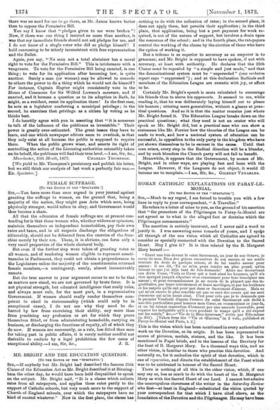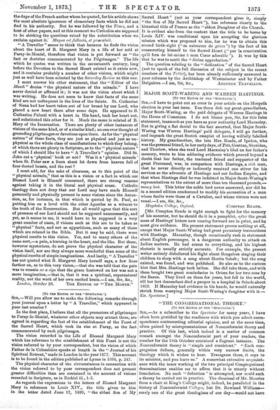ROMAN CATHOLIC EXPLANATIONS ON PARAY-LE- MONIAL.
[To THE EDITOR OF THE SPEOTATOR."]
SIR,—Much to my regret, I am forced to trouble you with a few lines in reply to your correspondent, "A Traveller."
He refers to a letter of mine to you, as the ground of his assertion, that "the promoters of the Pilgrimages to Paray-le-Monial are not agreed as to what is the alleged fact or doctrine which the Pilgrimages commemorate."
The assertion is entirely incorrect, and I never said a word to justify it. I was answering some remarks of yours, and I spolie all through of the one vision which all Catholics are agreed to- consider as specially connected with the Devotion to the Sacred Heart. May I give it? It is thus related by the B. Margaret, Mary herself :—
" Etant une fois devant le saint Sacrement, an jour de son Octave, je recus de mon Dieu des graces excessives de son amour, at me sentis- towhee du desir de quelcine retour, at de mi rendre amour pour amour : il me dit, 'Tu no in'en peux rendre un plus grand, qu'en faisaut ce quo j'ai deja taut de fois demande2 Alors me decouvrant son divin Cceur, 'Voila ce Cceur qui a taut aim e les hommes, n'a rien epargne jusqu'a s'dpuiser et se consommer pour lour temoigner son amour ; et pour reconnaissance je no recois de la plupart quo des in- gratitudes, par leurs irreverences et leurs sacriNges, et par les froideurs. et les mepris gulls out pour' moi dans ce Sacrement d'amour. Mais co qui m'est encore le plus sensible oat quo ce sont des emirs qui me sont consacres qui m'en usent ainsi. C'est pour cola clue je to demande qua le premier Vendredi d'apres l'octave du saint Sacrament soit dedie une fete particuliere pour honorer mon Coeur, en communiant ce et en lui faisant reparation d'honneur par une amende honorable, pour reparer les indb'miWs gull a recu pendant le temps gull a etd exposé. sur les autels," &c.—" Vie de 12 Bien-heureuse," &rite par Elle-memo (p. 355). [Taken from the "Vie et CEuvres," in 2 vols., published at Paray-le-Monial and Paris, t. 2.]
This is the vision which has been mentioned in every authoritative work on the Devotion, as its origin. It has been represented in scores of pictures, medals, statues, and the like. It has been mentioned in Papal briefs, and in the lessons of the Breviary for the feast of B. Margaret Mary. In a thousand ways this, and no other vision, is familiar to those who practise this devotion. And naturally so, for it embodies the spirit of that devotion, which is- one of reparation, and directs the establishment of the Feast which was to be celebrated in honour of the Sacred Heart.
There is nothing of all this in the other vision, which, if one- may say so, has as much to do with the heart of the B. Margaret Mary as with the Sacred Heart of our Lord. I cannot but admire the unscrupulous cleverness of the writer in the Saturday Review- who first—at least in England—substituted the vision. quoted by your correspondent for that which I have cited above, as the- foundation of the Devotion and the Pilgrimages. He may have been
the dupe of the French author whom he quoted, for his article shows the most absolute ignorance of elementary facts which he did not find in his authority. But ha was followed by the Times, and a boat of other papers, and at this moment we Catholics are supposed to be shirking the questions raised by the substitution when we exclaim against it: Magna eat fallacia, et prawaluit.
"A Traveller" seems to think that because he finds the vision about the heart of B. Margaret Mary in a life of her sold at Paray-le-Monial, therefore that vision is put forward as "the fact or doctrine commemorated by the Pilgrimages." The life which he quotes was written in the seventeenth century, long before the Devotion to the Sacred Heart existed as it exists now, and it contains probably a number of other visions, which might just as well have been selected by the Saturday Review as this one.
I must answer his other statement, that the "Editor of the Month" denies "the physical nature of the miracle." I have never denied or affirmed it ; it was not the vision about which I was writing. He does not seem to know that facts of the same kind are not unfrequent in the lives of the Saints. St. Catharine of Siena had her heart taken out of her breast by our Lord, who placed a new heart there after some days. He appeared to B. Catharine Paluzzi with a heart in His hand, took her heart out, and substituted this other for it. Machthe same is related of B. Mary of the Incarnation. There are plenty of other instances of visions of the same kind, or of a similar kind; no one ever thought of grounding pilgrimages or devotions upon them. As for the "physical nature" of these facts, they are just as physical and just as un- physical as the whole class of manifestations to which they belong, of which there are plenty in Scripture, as to the " physical nature" of which I should like to have" A Traveller's" opinion. Did St. John eat a 'physical' book or not? Was it a physical miracle' when St. Peter saw a linen sheet let down from heaven full of four-footed beasts, and the rest ?
I must add, for the sake of clearness, as to this point of the 4' physical miracle," that as this is a vision or a fact in which our Blessed Lord is Himself concerned, there are strong reasons against taking it in the literal and physical sense. Catholic theology does not deny that our Lord may have made Himself personally and physically present in some visions since the Ascen- sion, as, for instance, in that which is quoted by St. Paul, as putting him on a level with the other Apostles as a witness to the truth of the Resurrection. But all would agree that this sort of presence of our Lord should not be supposed unnecessarily, and yet, as it seems to me, it would have to be supposed in a very great number of cases, if visions such as this are to be taken as "physical" facts, and not as apparitions, such as many of those which are related in the Bible. But it may be said, there were physical results to this vision. Yea, and to many others of the same sort,—a pain, a burning in the heart, and the like. But these, however mysterious, do not prove the physical character of the vision itself, nor are they-always more wonderful than some of the physical results of simple imaginations. And lastly, "A Traveller" has not quoted what B. Margaret Mary herself says, a few lines farther on, as to this very vision,—that she was told that the pain was to remain as a sign that the grace bestowed on her was not a mere imagination,—that is, that it was a spiritual, supernatural reality, not the work of her own excited brain.—I am, Sir, &c., London, October 26. THE EDITOR OF "THE M.ONTIL"



































 Previous page
Previous page